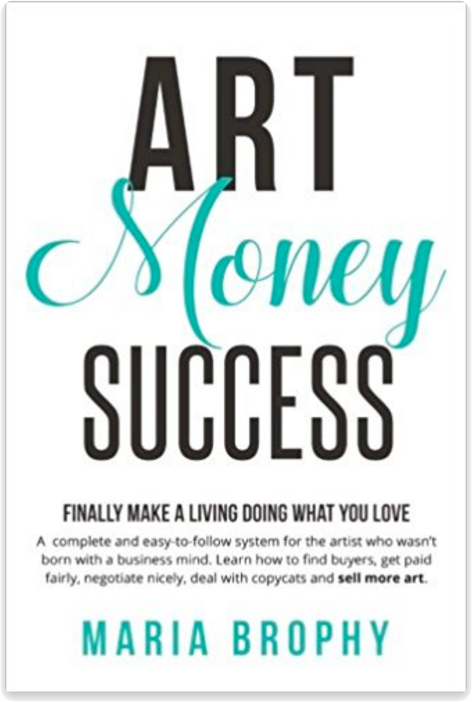 “I am always doing things I can’t do. That’s how I get to do them.” Picasso
“I am always doing things I can’t do. That’s how I get to do them.” Picasso
Do people recognize your artwork when they see it? Can the viewer identify that YOU are the artist before they even see your signature?
Picasso pulled that off. Shepard Fairey is working it on a smaller scale, and growing every day. And my husband Drew Brophy has managed to build strong recognition of his artwork in the lifestyle arena.
Many artists aspire to have their artwork, style and name easily recognized just like Picasso’s. It doesn’t happen overnight, and for many artists, unfortunately, it will never happen.
How can YOU ensure that your art and your name become well known?
The answer is more simple than you think and it has three parts:
- Insist on keeping ownership to all copyrights to your artwork.
- Insist that your signature is printed on everything that your artwork is printed on.
- Hit large numbers of people with your art.
I first heard of Shepard Fairey many years ago because of his Obey The Giant stickers that were mass-distributed worldwide. The number of people who saw his Obey stickers was massive, and I believe it was the catalyst that led to his success.
Drew started out as a “surf artist”, painting mostly surf related images for companies and collectors in the surf market.
In that market, many freelance artists who design for Billabong and Quicksilver and other surf companies make two very bad decisions: They sign away their copyrights and they don’t ask that their name be printed on the items.
Now, of course surf companies don’t want your name on their t-shirts. They are pushing their brand, not yours. Also, some of them play this game where they get you to do the work, and then they won’t cut you a check until you sign away your rights. To avoid being sucked into this situation, make sure that before you do the work, there is an understanding, in writing, that you retain all rights (everything is negotiable).
Drew’s first big push out into the public as an artist was when he teamed up with a small company named Lost. They made surfboards in San Clemente and in 1996 Drew got a freelance job painting their boards. His paintings became popular very quickly. The requests increased and he was painting ten surfboards a day. They were shipped all over the country, and over time, Lost became one of the top surfboard manufacturers in the U.S.
Drew’s name went on every surfboard. People saw his name. They came to know his distinct style. He was flown all over the world by companies who wanted him to paint their production boards. He went to Brazil, France, Spain, Peru, and he became known globally in the surf market as an artist.
Then Lost started to make clothing. They commissioned Drew to paint designs for board shorts and t-shirts. And again, his name went on everything. He kept the original paintings and the copyrights to his artwork.
If Drew would have followed the status quo and left his name off of everything, no one would have known that it was him behind the artwork. They would have thought it was an identity of Lost, a scenario that is very common with artists in the action sports niche, and others as well.
Though Lost was Drew’s main client, he created work for many other companies during the six years that he painted for them. Art directors from many different companies came to him to design their t-shirts or products.
And to this date, there have been millions of t-shirts and cool products (skateboards, surfboards, indo boards, beach towels, skins, etc.) with Drew’s art. Because his name is on them, many more people become familiar with his style and name every day.
Sometimes as an artist you’ll run into resistance with having your name shown on the work you do.
The resistance might be on your end – you’re afraid to ask. You don’t want to be a pain in the ass artist to your client.
Or, the client doesn’t want your name on it. If that’s the case, you’ll have to ask why. Does your signature take away from the aesthetics of the product? Is it confusing to the end consumer? Or is it that “we’ve always done it this way.” Discuss it, ask questions, and then convince them that the end consumer WANTS to know who the artist is.
(If a product has artwork on it that looks like Drew’s, and Drew’s signature isn’t on it, that’s a clue that It’s a knock-off. This has been a good argument for those companies who resist printing the signature.)
Artist Phil Roberts is well known as an artist in the Surf Industry. Recently one of his beautiful oil paintings was used for Kelly Slater’s 3D movie called ULTIMATE WAVE TAHITI. I was excited for Phil when I saw the full page poster in an advertisement in Surfer Magazine. That is, until I realized that Phil’s name was nowhere to be found on the page.
So, if you don’t know Phil Roberts and you aren’t familiar with his style, you have no idea who painted this masterpiece.
This does no good for the artist, and it isn’t good for the company, either. People WANT to know who painted something. It gives the project or company a more personal feel.
One way to avoid this type of “snafu” would have been to ask the fine folks that commissioned you to allow you to see the final posters BEFORE they are printed and used in any form. We always insist on seeing everything before it’s released to the public.
This is where I have been accused of being a control freak. I admit it; I’m a freak for control. But there are really good reasons to have control over what happens to your artwork; you need to be sure that when it comes to your art and your name and anything that can affect your “brand”, that it’s done according to YOUR standards.
I insist that all of our clients send us a jpg of whatever they’ve printed Drew’s art on so that we can give final approval. Sometimes they forget. So I remind them. The first thing I check for is the clarity of Drew’s signature. Sometimes they accidentally leave it off. So I remind them. And then they fix it.
It’s not a big deal to ask for what you want. Most people that you work with are going to want to please you just as much as you want to please them. It should be a two-way street.
So, don’t feel funny about asking for the things you want, especially something as important as your signature on your own artwork.
The more your name is seen on your art, the more you will be remembered as an artist, the more the phone will ring, the more people will visit your website.
After all, most of us want to be known for the fine work we do, don’t we?
Signed, Maria Brophy xxoo
Was this post helpful to you? Please, SUBSCRIBE to my e-mail feeds by putting your e-mail address in the white box below. You’ll get my posts in your in-box and you won’t miss anything!














